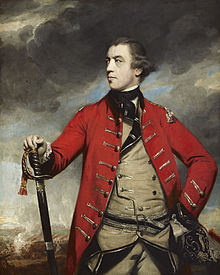
Robert Baddeley (1733–1794) was an English actor. His parentage is unknown, as is his place of birth, though the latter may have been London. He worked as a cook and valet, and one of his employers was the actor-manager Samuel Foote, who may have inspired him to take to the stage. He spent three years following another employer on a Grand Tour, which helped him to develop the facility with languages and accents which was to be a hallmark of his career.

Spranger Barry was an Irish actor.

General John Burgoyne was a British general, dramatist and politician who sat in the House of Commons from 1761 to 1792. He first saw action during the Seven Years' War when he participated in several battles, most notably during the Portugal campaign of 1762.

Edward Smith-Stanley, 12th Earl of Derby PC, usually styled Lord Stanley from 1771 to 1776, was a British peer and politician of the late eighteenth and early nineteenth centuries. He held office as Chancellor of the Duchy of Lancaster in 1783 in the Fox–North coalition and between 1806 and 1807 in the Ministry of All the Talents.

The Theatre Royal, Drury Lane, commonly known as Drury Lane, is a West End theatre and Grade I listed building in Covent Garden, London, England. The building faces Catherine Street and backs onto Drury Lane. The present building, opened in 1812, is the most recent of four theatres that stood at the location since 1663, making it the oldest theatre site in London still in use. According to the author Peter Thomson, for its first two centuries, Drury Lane could "reasonably have claimed to be London's leading theatre". For most of that time, it was one of a handful of patent theatres, granted monopoly rights to the production of "legitimate" drama in London.
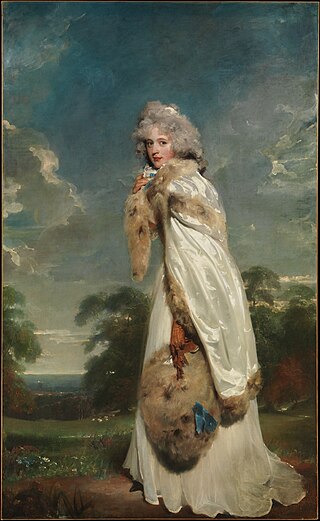
Elizabeth Farren was an Irish actress of the late 18th century. Born in Cork in 1759, her father, George Farren was a surgeon. His drinking habits brought on early death and his widow returned to Liverpool. Her mother went on the stage to support herself and her children. Elizabeth first appeared on the London stage in 1777 as Miss Hardcastle in She Stoops to Conquer and the following year appeared at Drury Lane which, along with the Haymarket Theatre became her primary venues for the rest of her acting career. She had over 100 characters in her repertoire including Shakespeare and various contemporary comedies and dramas. She was often compared to Frances Abington, who was her only real rival. Her last appearance was in April 1797, two months before her marriage to Edward Smith-Stanley, 12th Earl of Derby. They had one daughter.
The Old American Company was an American theatre company. It was the first fully professional theatre company to perform in North America. It also played a vital role in the theatre history of Jamaica. It was founded in 1752 and disbanded in 1805. It was known as the Hallam Company (1752–1758), the American Company (1758–1785) and the Old American Company (1785–1805). With a few temporary exceptions, the Company enjoyed a de facto monopoly of professional theatre in the United States until 1790.
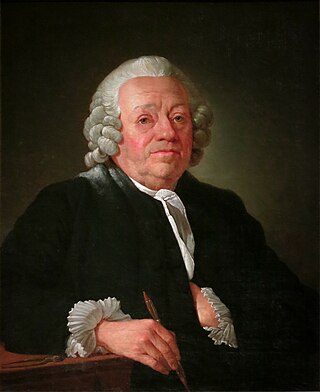
Jean-Nicolas Servan, also known as Giovanni Niccolò Servandoni was an Italian decorator, architect, scene-painter, firework designer and trompe-l'œil specialist.

Jane Pope was an English actress.
The King's Company was one of two enterprises granted the rights to mount theatrical productions in London, after the London theatre closure had been lifted at the start of the English Restoration. It existed from 1660 to 1682, when it merged with the Duke's Company to form the United Company.

William Smith, known as "Gentleman Smith", was a celebrated English actor of the 18th century who worked with David Garrick, and was the original creator of the role of Charles Surface in Richard Brinsley Sheridan's The School for Scandal.

Epsom Downs is a Grade 1 racecourse in a hilly area near Epsom in Surrey, England which is used for thoroughbred horse racing. The "Downs" referred to in the name are part of the North Downs.

The Heiress is a comedy play by the British playwright and soldier John Burgoyne. The play debuted at the Drury Lane Theatre on 14 January 1786. It concerns the engagement of Lord Gayville to Miss Alscrip, a fashionable woman he believes to be an heiress. Gayville later discovers that the woman who really stands to inherit the fortune is his true love Miss Clifford. The play was an enormous success, running for 31 performances in its initial season and being revived again the following year. The play was initially anonymous, but Burgoyne was soon widely reported to be the author and he acknowledged this after the play's debut.
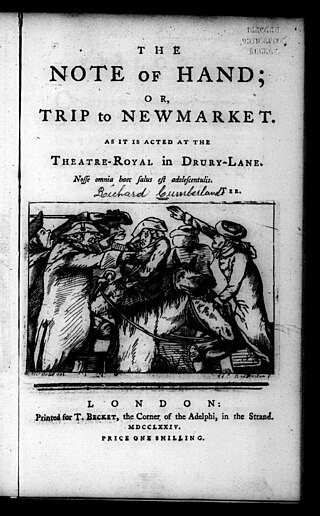
The Note of Hand, or Trip to Newmarket is a 1774 comedy play by the British writer Richard Cumberland. A farce it was the final play performed by David Garrick at the Drury Lane Theatre in London before his retirement. The Irish premiere took place at the Capel Street Theatre in Dublin on 10 March 1774. The original London cast included John Palmer as Revell, Samuel Cautherley as Rivers, Thomas Jefferson as Elder Rivers, John Moody as O'Connor MacCormuck, William Palmer as Francis, James William Dodd as Sapling, James Wrighten as Putty and Susan Greville as Mrs Cheveley.

Elizabeth Hartley (1750?–1824) was one of the most celebrated actresses on the London stage in the 18th century. She was also notorious for the role she played in society scandals including "The Vauxhall Affray".
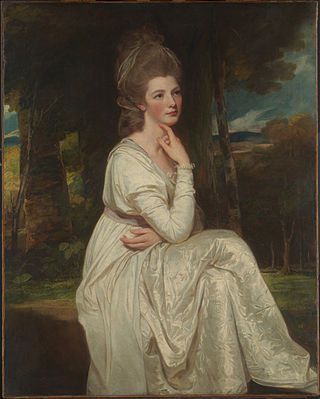
Elizabeth Smith-Stanley, Countess of Derby was an English peeress. As the eligible eldest daughter of the 6th Duke of Hamilton, she married the 12th Earl of Derby in 1774, giving birth to three children. Lady Derby was popular among society and she organised a ladies cricket match. She was a leader of fashion alongside the Duchess of Devonshire.

Jane Powell or Mrs Powell was a British actress. She was also known as Mrs Renaud and Mrs Farmer.

Mary Bulkley, née Wilford, known professionally as Mrs Bulkley, Miss Bulkley, and later Mrs Barresford, was an English eighteenth-century dancer and comedy stage actress. She performed at various theatres, especially Covent Garden Theatre, the Theatre Royal, Dublin, the Theatre Royal, Edinburgh, the Theatre Royal Haymarket and Shrewsbury Theatre. She performed in all or most of the Shakespearean comedies, and in several tragedies, besides many contemporary comedy plays. She played the part of Hamlet at least twice. She was considered a beauty when young, and her talent was praised. She married George Bulkley and later Captain Ebenezer Barresford, and openly took several lovers. Her early career was successful, but later she was hissed on stage due to her extra-marital affairs, and she died in poverty.
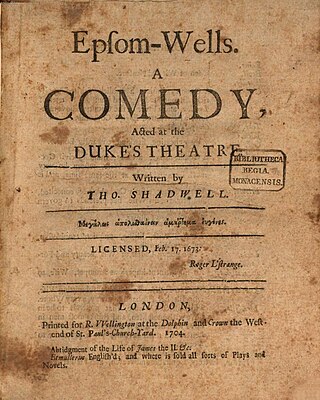
Epsom Wells is a 1672 restoration comedy by the English writer Thomas Shadwell. It was the first in a line of plays set in spa towns. The incidental music was composed by Nicholas Staggins. In the 1690s Henry Purcell scored a new staging of the play. It was performed at the Dorset Garden Theatre by the Duke's Company. The cast included Henry Harris as Rains, Thomas Betterton as Bevil, William Smith as Woodly, Cave Underhill as Justice Clodpate, Anne Gibbs as Lucia, Mary Betterton as Mrs Jilt, James Nokes as Bisket and Edward Angel as Fribble.
William Hamilton was an Irish stage actor of the eighteenth century.

